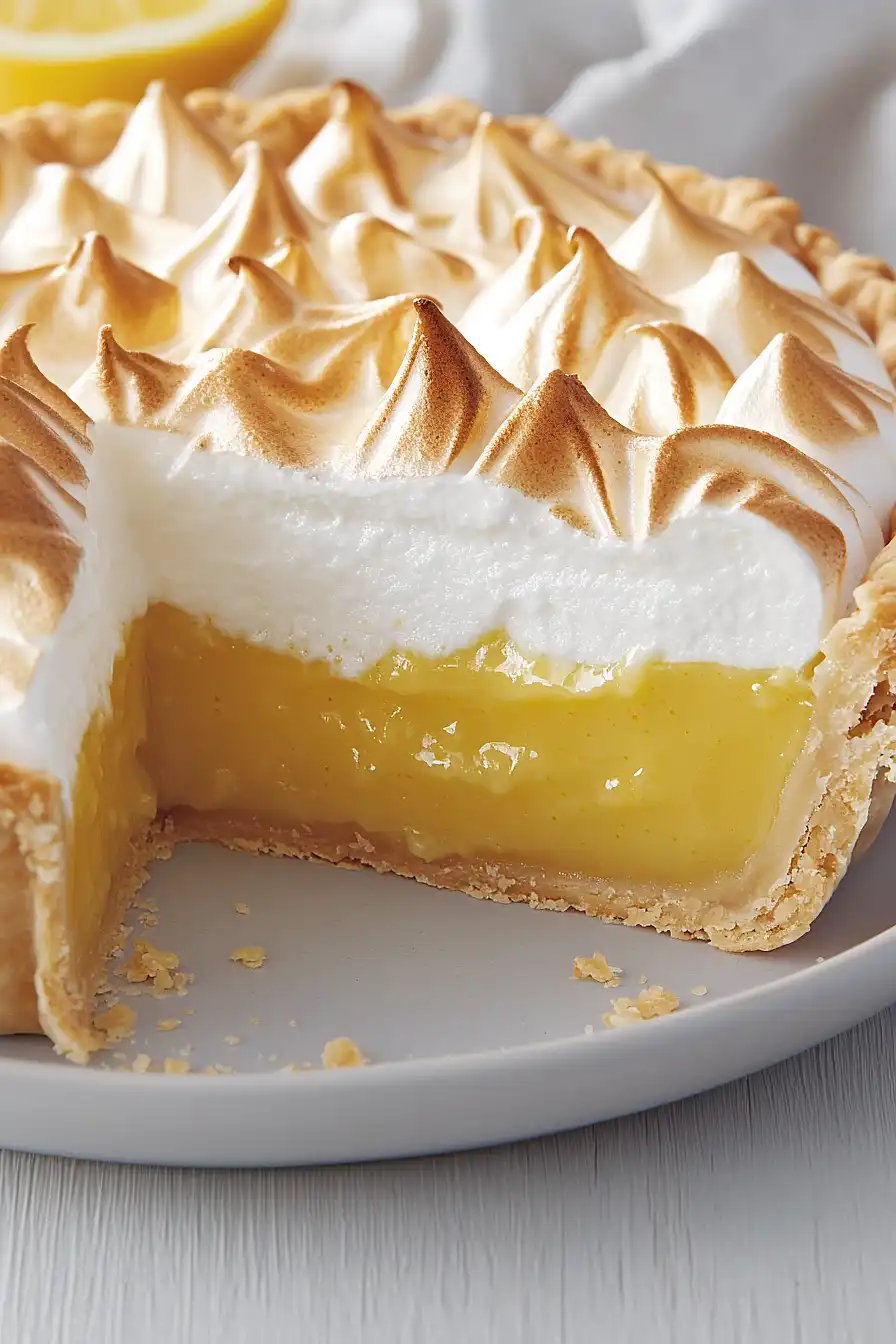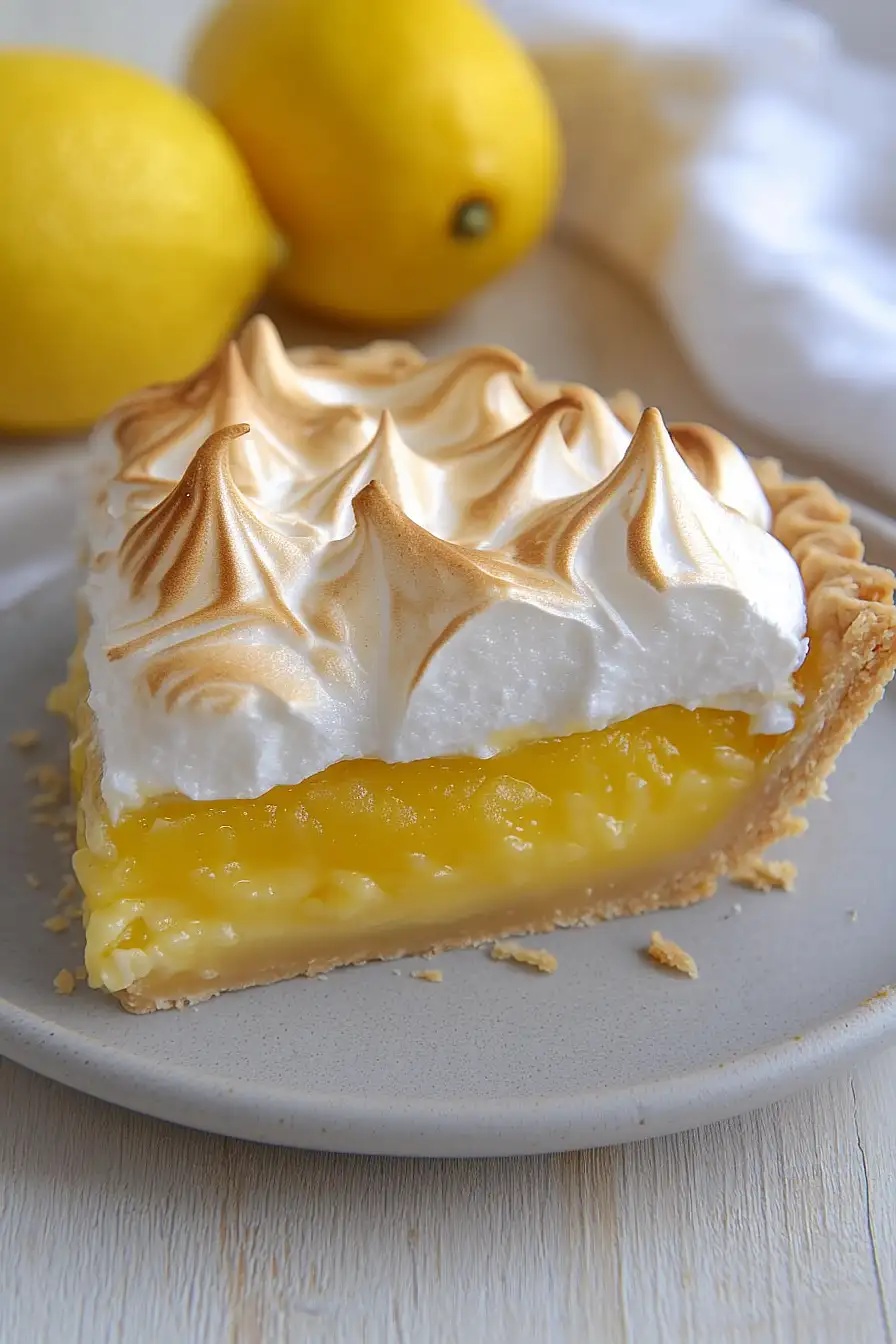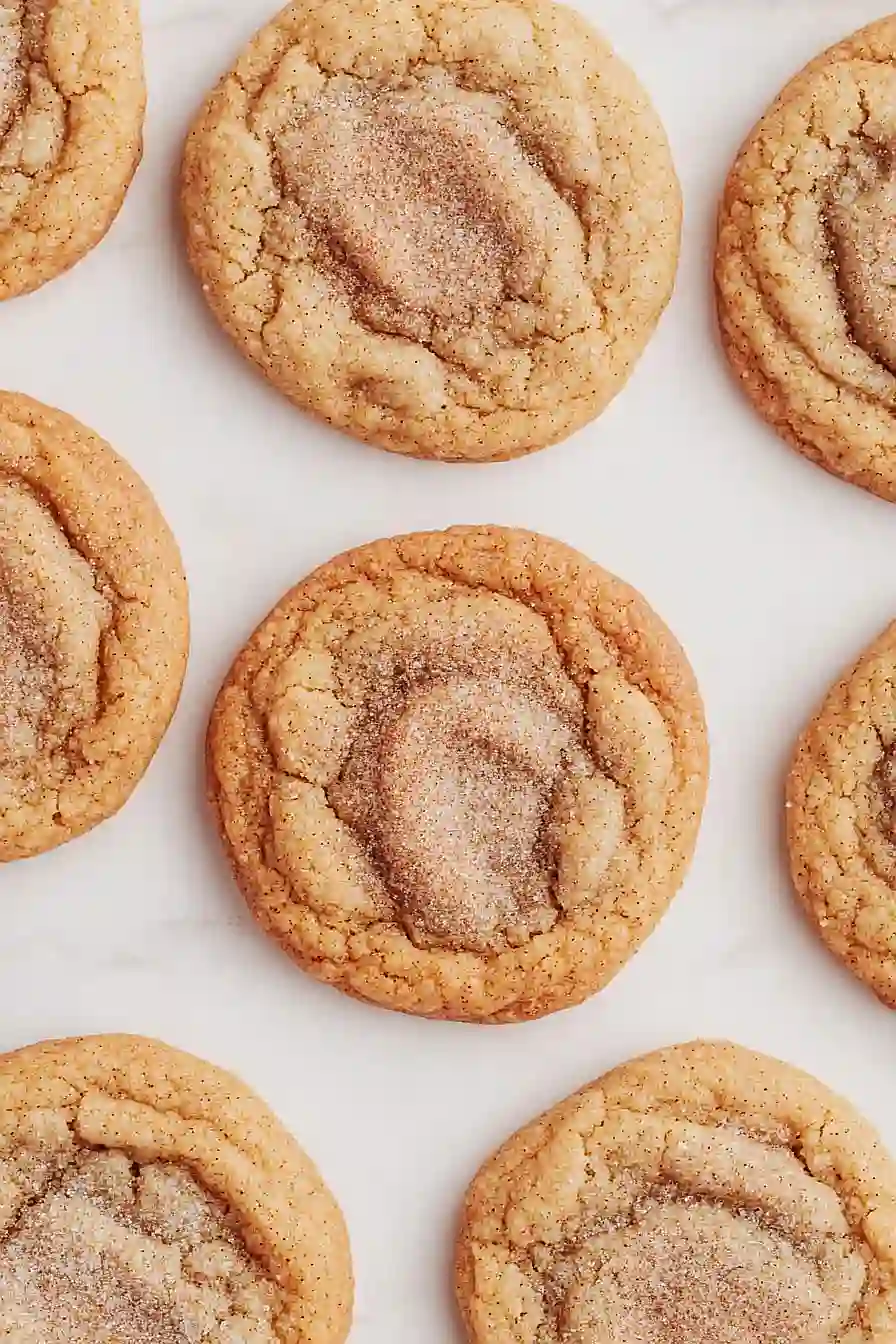Making a lemon meringue pie from scratch can feel pretty intimidating, especially when you’re staring at all those steps and wondering if your meringue will actually hold up. I get it – between getting the curd just right, making sure the pastry doesn’t get soggy, and praying the meringue doesn’t weep, there’s a lot that can go wrong.
But here’s the thing: Mary Berry’s lemon meringue pie recipe takes all the guesswork out of it. Her method is straightforward and forgiving, with clear steps that actually make sense, plus her little tricks help you avoid those common pitfalls that usually make people want to give up and buy one from the store instead.

Why You’ll Love This Lemon Meringue Pie
- Classic comfort dessert – This traditional lemon meringue pie brings back all those nostalgic feelings with its perfect balance of tart lemon filling and fluffy meringue topping.
- Impressive presentation – The towering meringue peaks and golden crust make this pie look like it came straight from a bakery, perfect for special occasions or when you want to wow your guests.
- Fresh lemon flavor – Using real lemon juice and zest from six lemons gives this pie a bright, tangy flavor that’s so much better than store-bought versions.
- Mary Berry’s trusted recipe – Following a recipe from the beloved British baking expert means you’re getting tried-and-true techniques that actually work.
- Make-ahead friendly – You can prepare the pastry and filling ahead of time, then add the meringue just before serving, making it great for entertaining.
What Kind of Lemons Should I Use?
For Mary Berry’s lemon meringue pie, you’ll want to use fresh lemons rather than bottled lemon juice for the best flavor. Look for lemons that feel heavy for their size and have bright, unblemished skin – these will give you the most juice and the best zest. Meyer lemons are a great choice if you can find them since they’re sweeter and less acidic than regular lemons, but standard supermarket lemons work perfectly fine too. When zesting, make sure to only get the yellow part of the peel and avoid the white pith underneath, which can make your filling bitter.

Options for Substitutions
While this classic lemon meringue pie has some ingredients you really shouldn’t mess with, there are a few swaps you can make:
- Plain flour: You can substitute with all-purpose flour if you’re in the US – it’s essentially the same thing. Avoid using self-raising flour as it will affect the pastry texture.
- Butter: Cold margarine or vegetable shortening can work in place of butter for the pastry, though you’ll lose some of that rich, buttery flavor.
- Icing sugar: Powdered sugar is the same thing if you’re shopping in the US. You can also make your own by blending regular caster sugar in a food processor until fine.
- Lemons: Fresh lemons are really best here – bottled lemon juice just won’t give you the same bright, fresh taste. If you must use bottled, you’ll need about 150ml/5fl oz of juice.
- Caster sugar: This is superfine sugar in the US. You can make your own by pulsing regular granulated sugar in a food processor for 30 seconds, but don’t substitute with regular sugar as it won’t dissolve properly in the meringue.
- Cornflour: This is cornstarch in the US – same ingredient, different name. Don’t skip this as it’s essential for thickening both the filling and stabilizing the meringue.
Watch Out for These Mistakes While Baking
The biggest mistake when making lemon meringue pie is adding the lemon filling while it’s still hot, which will cause your meringue to weep and create that dreaded soggy layer underneath – always let your curd cool to room temperature first.
Another common error is not cooking the lemon curd long enough, so make sure it coats the back of a spoon and has thickened properly before removing from heat, otherwise you’ll end up with a runny filling that won’t set.
When making the meringue, ensure your bowl and beaters are completely clean and grease-free (even a tiny bit of egg yolk will prevent proper whipping), and gradually add the sugar while beating to create stable, glossy peaks.
Finally, bake the assembled pie immediately after adding the meringue and avoid opening the oven door during baking, as temperature fluctuations can cause the meringue to crack or collapse.

What to Serve With Lemon Meringue Pie?
This tangy, sweet pie is honestly perfect on its own, but a dollop of lightly whipped cream on the side never hurts if you want to balance out some of that bright lemon flavor. Since it’s such a rich dessert, I like to serve it after a lighter meal – maybe some grilled fish or a simple roast chicken dinner. A cup of black tea or coffee pairs beautifully with the citrusy filling and sweet meringue, especially if you’re serving it for an afternoon treat. Fresh berries like strawberries or raspberries make a nice garnish and add a pop of color to each slice.
Storage Instructions
Keep Fresh: Lemon meringue pie is best enjoyed the day it’s made, but you can store it in the fridge for up to 2 days. Cover it loosely with plastic wrap or place it under a cake dome to protect the meringue. The meringue might weep a little after the first day, but it’ll still taste great!
Make Ahead: You can definitely get a head start on this pie! Bake the pastry case and make the lemon curd filling up to a day ahead, then store them separately in the fridge. When you’re ready to serve, just whip up the meringue and assemble everything for the final bake.
Serve: This pie is meant to be served chilled, so take it straight from the fridge to the table. If you’ve stored it overnight, let it sit at room temperature for about 10 minutes before slicing – this makes it easier to cut clean pieces without the meringue cracking too much.
| Preparation Time | 30-45 minutes |
| Cooking Time | 35-45 minutes |
| Total Time | 65-90 minutes |
| Level of Difficulty | Medium |
Estimated Nutrition
Estimated nutrition for the whole recipe (without optional ingredients):
- Calories: 3900-4100
- Protein: 45-55 g
- Fat: 170-185 g
- Carbohydrates: 540-570 g
Ingredients
For the pastry base:
- 8 oz plain flour
- 6 oz unsalted butter
- 1 3/4 oz confectioners’ sugar
- 1 large egg, beaten
For the lemon layer:
- Zest and juice from 6 lemons
- 2 1/4 oz cornstarch
- 9 oz superfine sugar
- 6 egg yolks
- 16 fl oz water
For the meringue:
- 4 egg whites
- 8 oz superfine sugar
- 2 tsp cornstarch
Step 1: Make and Chill the Pastry Dough
- 8 oz plain flour
- 6 oz unsalted butter
- 1 3/4 oz confectioners’ sugar
- 1 large egg, beaten
- 1 tablespoon water (from water in ingredient list)
Preheat the oven to 180C/350F/Gas 4.
In a food processor, blend the plain flour and unsalted butter together until the mixture looks like fine breadcrumbs.
Add the confectioners’ sugar, beaten egg, and one tablespoon of water.
Process again until the dough comes together in a ball.
Tip the dough onto a work surface and roll it out to about 3mm thickness.
Carefully lift and use it to line a 23cm/9in loose-bottomed flan tin, making sure not to stretch the pastry.
Cover with cling film and chill in the refrigerator for 30 minutes.
I like to handle the pastry gently in this stage to ensure a crisp, non-shrunken crust.
Step 2: Blind Bake the Pastry Case
Take the chilled pastry-lined tin from the fridge, trim any excess pastry, and gently press the top edge so it stands slightly higher than the tin.
Line the case with parchment and fill with baking beans.
Bake in the preheated oven for 15 minutes.
Remove the beans and parchment, then return the case to the oven for another 5 minutes.
Remove from the oven and reduce the temperature to 170C/340F/Gas 3½.
Step 3: Cook the Lemon Filling
- zest and juice from 6 lemons
- 2 1/4 oz cornstarch
- 16 fl oz water
- 9 oz superfine sugar
- 6 egg yolks
Mix the zest and juice from the lemons with 2 1/4 oz cornstarch until it forms a smooth paste.
Measure out 16 fl oz water and bring it to a boil in a pan.
Add the lemon-cornstarch mixture to the hot water, stirring constantly over the heat until the mixture thickens.
Remove from heat.
In a bowl, whisk together 9 oz superfine sugar and 6 egg yolks.
Gradually whisk this into the lemon mixture in the pan.
Stir over medium heat until the filling thickens further.
Set aside for a few minutes, then pour the filling into the baked pastry case from Step 2.
Step 4: Prepare the Meringue
- 4 egg whites
- 8 oz superfine sugar
- 2 tsp cornstarch
In a stand mixer, whisk the egg whites until soft peaks form.
Gradually add the superfine sugar, whisking continuously until the meringue is stiff and glossy.
Sprinkle in 2 tsp cornstarch and whisk again to incorporate.
I find adding cornstarch helps stabilize the meringue so it holds up beautifully when baked.
Step 5: Assemble the Pie and Bake
- lemon filling from Step 3
- meringue from Step 4
- baked pastry case from Step 2
Spoon the meringue on top of the lemon filling (from Step 3) in the baked pastry case.
Spread the meringue to entirely cover the filling and use the back of a spoon to create swirls on top.
Bake in the oven (now set at 170C/340F/Gas 3½) for about 15 minutes, or until the meringue is lightly golden and crisp and the filling is completely set.
Step 6: Cool and Serve
Allow the lemon meringue pie to cool completely before cutting into slices, or serve it very slightly warm if you prefer.
For a cleaner slice, I like to chill the pie in the fridge for an hour before serving.

Golden Mary Berry's Lemon Meringue Pie
Ingredients
For the pastry base:
- 8 oz plain flour
- 6 oz unsalted butter
- 1 3/4 oz confectioners' sugar
- 1 large egg, beaten
For the lemon layer:
- zest and juice from 6 lemons
- 2 1/4 oz cornstarch
- 9 oz superfine sugar
- 6 egg yolks
- 16 fl oz water
For the meringue:
- 4 egg whites
- 8 oz superfine sugar
- 2 tsp cornstarch
Instructions
- Preheat the oven to 180C/350F/Gas 4. In a food processor, blend the plain flour and unsalted butter together until the mixture looks like fine breadcrumbs. Add the confectioners' sugar, beaten egg, and one tablespoon of water. Process again until the dough comes together in a ball. Tip the dough onto a work surface and roll it out to about 3mm thickness. Carefully lift and use it to line a 23cm/9in loose-bottomed flan tin, making sure not to stretch the pastry. Cover with cling film and chill in the refrigerator for 30 minutes. I like to handle the pastry gently in this stage to ensure a crisp, non-shrunken crust.
- Take the chilled pastry-lined tin from the fridge, trim any excess pastry, and gently press the top edge so it stands slightly higher than the tin. Line the case with parchment and fill with baking beans. Bake in the preheated oven for 15 minutes. Remove the beans and parchment, then return the case to the oven for another 5 minutes. Remove from the oven and reduce the temperature to 170C/340F/Gas 3½.
- Mix the zest and juice from the lemons with 2 1/4 oz cornstarch until it forms a smooth paste. Measure out 16 fl oz water and bring it to a boil in a pan. Add the lemon-cornstarch mixture to the hot water, stirring constantly over the heat until the mixture thickens. Remove from heat. In a bowl, whisk together 9 oz superfine sugar and 6 egg yolks. Gradually whisk this into the lemon mixture in the pan. Stir over medium heat until the filling thickens further. Set aside for a few minutes, then pour the filling into the baked pastry case from Step 2.
- In a stand mixer, whisk the egg whites until soft peaks form. Gradually add the superfine sugar, whisking continuously until the meringue is stiff and glossy. Sprinkle in 2 tsp cornstarch and whisk again to incorporate. I find adding cornstarch helps stabilize the meringue so it holds up beautifully when baked.
- Spoon the meringue on top of the lemon filling (from Step 3) in the baked pastry case. Spread the meringue to entirely cover the filling and use the back of a spoon to create swirls on top. Bake in the oven (now set at 170C/340F/Gas 3½) for about 15 minutes, or until the meringue is lightly golden and crisp and the filling is completely set.
- Allow the lemon meringue pie to cool completely before cutting into slices, or serve it very slightly warm if you prefer. For a cleaner slice, I like to chill the pie in the fridge for an hour before serving.















